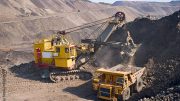In early February, Bloomberg reported that Apple Inc. was in direct talks with an undisclosed mining company to secure long-term cobalt supplies to support the mounting demands of the company’s power-hungry device lineup.
Cobalt, a hard, silver-grey metal once used for jewellery and paints, is the main component for today’s lithium-ion batteries. Valued at over US$37 per lb. — a 100% increase from just the year before — the metal is a coveted chalice for power-hungry manufacturers seeking footholds in the narrowing space.
The potential deal would mark one of several negotiated by vertically integrated manufacturers (VIMs) in recent months to secure supplies of metals for expanding production targets. BMW, Volkswagen and Samsung are just some of the industry giants rallying to align themselves with raw material producers.
This transformation will likely transition well beyond power-centric commodities into other non-renewable resources — metal or otherwise — and may have positive consequences beyond increased shareholder value.
First, metal commodity prices are notoriously fickle, with cycles becoming increasingly sporadic — contracting and swelling in greater frequency and amplitude than the one before.
In contrast, demand for consumer products like cellphones, home electronics, and in recent years, electric vehicles, has either remained steady or even increased through much of the economic downturn of the past decade.
By shortening the supply chain, commodity prices — and by extension, mining investment — are likely to see lower volatility in the wake of more predictable supply and demand forecasts.
Second, while pre-emptive stakeholder engagements and CSR outreach programs are a mainstay of the mining business, trendsetters like Apple, Samsung, and purveyors of all things shiny and new, which have traditionally commanded unwavering brand loyalty in spite of numerous public snafus (e.g., compare the number of glittery Apple logo bumper stickers on rear fenders versus, say, Glencore), may now find themselves under increased scrutiny.
Over 60% of the world’s cobalt is produced from the Democratic Republic of the Congo, where evidence of child labour in mines has cast mounting scrutiny on the underlying socio-economic costs of the supply chain.
VIMs exposed to legal and ethical liabilities will quickly bridge the public’s perception disconnect between source material and end-product.
Much the same way that savvy food consumers helped spawn the “farm-to-table” food chain model, the social license liabilities of operating in conflict zones will likely drive VIMs to re-evaluate their risk profiles and adapt a similar “mine-to-store shelf” supply chain model, and seek out friendlier mining jurisdictions, or work with existing jurisdictions to improve stakeholder engagement and incentives.
With mounting pressure to lower production costs, VIMs will continue to seek paths of least resistance to fuel their burgeoning material consumption — meaning all options are on the table.
Only last year did Apple boldly announce in their 2017 Environmental Responsibility Report that they would seek to only use renewable materials in their devices in the near future. This monumental shift in how VIMs will look to fill the supply chain means that mining companies will need to revisit their core competencies.
Advances in biogeochemistry, metal recycling, aqueous metal precipitation and synthetic polymers are helping to redefine the literal building blocks of society.
Mining as a pure earth-moving endeavour may soon be a thing of the past, as we seek out new and innovative ways to source materials to build our future world.
The vertical transformation of mining has begun — finally.
 — Kurt Breede, P.Eng. is the Director of Industry Partnerships at the Lassonde Institute of Mining, University of Toronto, one of the leading mining research institutes in Canada. The views and opinions expressed in this article are those of the author.
— Kurt Breede, P.Eng. is the Director of Industry Partnerships at the Lassonde Institute of Mining, University of Toronto, one of the leading mining research institutes in Canada. The views and opinions expressed in this article are those of the author.






Be the first to comment on "Commentary: Apple and the vertical transformation of mining"